 Over 1,000 robots have performed a synchronised dance routine in China, and consequently broken a world record. 1,040 identical robots, each under 44 centimetres in height, began their synchronised dance routine in Qingdao city. 1,007 finished the challenge, setting a new Guinness World Record for the largest simultaneous robot dance which is nearly double the previous record of 540, again achieved in China.
Over 1,000 robots have performed a synchronised dance routine in China, and consequently broken a world record. 1,040 identical robots, each under 44 centimetres in height, began their synchronised dance routine in Qingdao city. 1,007 finished the challenge, setting a new Guinness World Record for the largest simultaneous robot dance which is nearly double the previous record of 540, again achieved in China.
The dancing machines broke the record at the Qingdao Beer Festival, controlled using just one mobile phone. To break the record, they had to dance for a full minute, however some robots were disqualified because they either did not dance or fell over. The majority of the robots completed the routine in unison as an uber-disciplined mechanical dance group. In order to break the record, the robots were fitted with special encryption technology in order to reduce radio frequency inference from other mobile phones and Bluetooth devices nearby, to aim for optimum success.
There have been many other world records achieved in dance over the years, featuring all different styles of dance.
The largest Kaikottikali dance was performed solely by women during the Malayalam festival of Onam, as one of the most popular South Indian dances from the Hindu communities of the state of Kerala. Led by choreographer Jitha Binoy, the successful attempt at the record formed part of the Thanima Arts Festival in Irinjalakuda (India) in January 2016. It saw 5,211 dancers perform in front of audience of over 55,000.
The most breakdance windmills in 30 seconds was achieved by LeeRoy Bailey, a break-dancing expert from the UK, performing 46 windmill moves. The record of 2009 was beaten a year later by Italian street dancer Mauro Peruzzi, who managed 50 revolutions during the Sony Ericsson UK B-Boy Championships World Finals, in London in October 2010. The Largest Tap Dance was first recorded in 1977 with 500 tappers at the London BBC Television Centre. The record now stands at 6,951 people, for a dance which took place in Stuttgart, Germany in May 1998.
Category: Uncategorised
Being a dance parent
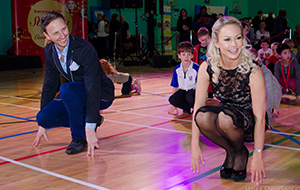 Dance parents. Studio life may be something old hat that you have your own experience of from way back when, or it may be a new journey, learning about costumes, stretching and types of pointe shoe afresh. What happens when your child wants to become a professional dancer? How can you encourage their dreams but help keep their mind focused and their feet on the ground? The dance industry is renowned for its competitiveness and there may be lots to consider.
Dance parents. Studio life may be something old hat that you have your own experience of from way back when, or it may be a new journey, learning about costumes, stretching and types of pointe shoe afresh. What happens when your child wants to become a professional dancer? How can you encourage their dreams but help keep their mind focused and their feet on the ground? The dance industry is renowned for its competitiveness and there may be lots to consider.
Dance, unlike sport, does not have clear steps as to ensuring success. Success in dance may mean many things, as becoming performer, choreographer, casting director, abroad or at home. Dancing is extremely subjective and aesthetic, and there is no correct age to begin focusing on and training for a career in dance. Most dancers train vocationally from 16 or 18, however this has shifted, with institutions preferring to take students at 18 after they have completed school exams and gained some life experience. Often physical assessments are required to ensure the body is ready for intense training, and strong enough to dance fulltime.
Some students begin fulltime training even earlier, attending stage schools where vocational training is balanced with academia. Often additional tutors are required as the hours in the classroom are low in comparison to those in the studio. It is important to gain academic qualifications too where possible, to give students the best possible start in life. It may be useful to seek guidance from those in similar positions, or who have done something similar in the past, as they will understand the requirements of the institution and the questions that may crop up. Training abroad may too be an option, so guidance here is even more important in ensuring the correct decision is made.
Dancing in the heat
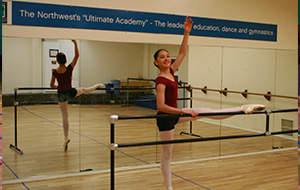 Summer in the northern hemisphere can spell lots of heat for dancers, taking into account the rising temperatures of public transport and hot studios as dancers sweat their classes away. Many drop-in classes and rehearsals continue throughout these months, so – like in the cold weather – it is important to take care of the body.
Summer in the northern hemisphere can spell lots of heat for dancers, taking into account the rising temperatures of public transport and hot studios as dancers sweat their classes away. Many drop-in classes and rehearsals continue throughout these months, so – like in the cold weather – it is important to take care of the body.
In a humid studio, it can be easy to feel very warm and more flexible than usual. Take care not to overstretch or push your flexibility, as muscles can become damaged or even torn through this false sense of security. The muscles will be warmer, but this does not permanently increase their length or pliability, and it can be easy to push them too far. Keep the muscles of the body secure by balancing flexibility with strength, listen to your body and take care not to slip on any sweaty patches on the studio floor!
Ensure you drink plenty of water whilst you are dancing, as dehydration can lead to muscle stiffness. Sweating more than usual means more water is lost as the body tries to keep itself cool, so keep your water levels topped up. You can also eat certain foods to keep cool; for example, cucumbers and watermelon are hydrating due to the high water content, and will also mean you aren’t loading up on heavy foods that can make dancers feel lethargic in the heat.
Whilst class, rehearsal and performance times cannot be dictated by dancers, try to avoid midday exercise when the sun is at its hottest and highest. Cross-training is deemed extremely suitable for dancers, and there are ways to incorporate this into hot summer days, such as swimming or in the air conditioned gym. Longer days mean there is more opportunity to take advantage of these training methods, and the light makes exercising easier too!
The next season for DanceXchange
 DanceXchange, the Midlands-based dance house, recently announced its latest performance season at The Patrick Centre, Birmingham Hippodrome, running from 22 September–3 December 2016. A large and varied programme looks set to delight audiences of all ages, with the autumn season taking dance in the midlands up again after the success of the International Dance Festival Birmingham 2016 earlier this year in May.
DanceXchange, the Midlands-based dance house, recently announced its latest performance season at The Patrick Centre, Birmingham Hippodrome, running from 22 September–3 December 2016. A large and varied programme looks set to delight audiences of all ages, with the autumn season taking dance in the midlands up again after the success of the International Dance Festival Birmingham 2016 earlier this year in May.
The International Dance Festival Birmingham, which is DanceXchange’s largest programme, saw numerous dance performances take place across the city to great acclaim. With the new season of dance for the venue, it is set to offer something for everyone, from the English premiere of a family-friendly show at Christmas, to a visually mesmerising production, pushing the boundaries of both dance and digital technology.
The autumn 2016 season highlights include many delights. An international triple bill from the acclaimed National Dance Company Wales will see the company make their first visit to Birmingham with the production Folk. There will be performance art from the award-winning Alexander Vantournhout in a solo focused on the autobiography of his own body and also a brand new triple bill from 2Faced Dance, which showcases new works from three world-class female choreographers performed by an all-male company of dancers.
Moving away from gender, Alexander Whitley Dance Company’s Pattern Recognition will focus on cutting-edge dance and motion responsive technology, also featuring a score by critically-acclaimed electronic composer Scanner and Southbank Centre artist-in-residence cellist Oliver Coates. The international dance artist Didy Veldman’s The Happiness Project, the first project from her new company Umanoove, looks at combining live music and dance. Finally, there will be The Wolf and Peter, a retelling of Prokofiev’s famous Peter and the Wolf by CoisCéim Dance Theatre. The English premiere of this magical Christmas show for families will be told from the perspective of the Wolf.
Safeguarding in the studio
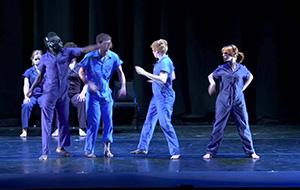 The safety of children in the dance student is something which is both a right and a legal requirement, with dance teachers obliged to uphold their policies on protecting the students who attend their studios for lessons.
The safety of children in the dance student is something which is both a right and a legal requirement, with dance teachers obliged to uphold their policies on protecting the students who attend their studios for lessons.
On a basic level, studios must be properly equipped for dance, with adequate flooring and enough space for the students who attend. This is in addition to supporting the emotional health and wellbeing of students, engaging with and enjoying an environment that is nurturing and supportive. This provides the joy of dance in addition to the physical safety aspect of correct anatomical instruction and injury prevention.
On a more complex level, dance students must also be safe from any form of abuse, be it when they are involved in dance, sport or any other associated activities. Gone are the days when dance students were manhandled into the correct alignment. Of course, dance is physical and touch is therefore an essential component of teaching, however parents, guardians and even students may be now hyper-aware of this, and feel uncomfortable about human contact and touch. Many teachers ask permission to use touch to aid in their teaching or corrections, in order to respect the student.
To further counter the limits of safety awareness in the twenty-first century, many dance teachers now operate with an ‘open door’ policy, in which parents are invited to view and engage with their child’s class to create a transparent and welcoming environment. Psychological safety is therefore just as important as physical safety, in that the student trusts they are safe during dance lessons. Many dance schools focus on building self-esteem and the emotional wellbeing of students in their duty of care, encouraging the students to communicate with and respect each other, and the teacher also.
The issue of child safety is one that is ever-present. For dance teachers the world over, developing a comprehensive safety policy is essential to protect both students and teachers.
Use of the mirror
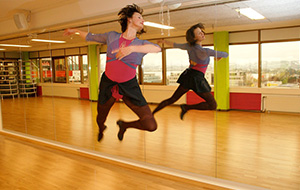 Mirrors in dance studios can be both a help and a hindrance. On one hand they can promote the aspiration towards a high level of technique in being able to observe the body as it works, yet equally it can encourage an unhealthy relationship with the body and what is capable of doing. Being aware of the body’s alignments is ultimately useful in working correctly and safely with good technique, its feedback being beneficial to a dancer’s training and daily routine.
Mirrors in dance studios can be both a help and a hindrance. On one hand they can promote the aspiration towards a high level of technique in being able to observe the body as it works, yet equally it can encourage an unhealthy relationship with the body and what is capable of doing. Being aware of the body’s alignments is ultimately useful in working correctly and safely with good technique, its feedback being beneficial to a dancer’s training and daily routine.
However mirrors can seem ever-present for dancers. For those that are young and susceptible to influence, this could have a detrimental effect on dancers’ abilities to abandon themselves in dance and trust their own bodies. Mirrors may equally encourage dancers to be too focused on their efforts in the studio: a large part of dance is also enjoying the movement and performing it, rather than being caught up with technique constantly.
This begs the question as to whether dancers learn better by observing themselves in the mirror to utilise correct technique, or whether it is best to learn without mirrors, to feel the movement and learn the movement sensations that way. This of course depends on whether there is an option of mirrors at all in a dance studio, and whether using them actually means dancers are just creating shapes rather than working the movement from the inside out.
Mirrors can be so prevalent in dance today, however, that it could be that dancers are so visually stimulated they increasingly rely on mirrors for visual feedback, rather than personally feeling corrections. Additionally mirrors can be used to keep in time with the other dancers in the room and even copy what they are doing, rather than trusting the body and listening to the music to create the same effect. Dancers can spend hours in front of mirrors, analysing their reflection and it can be easy to become overly critical and obsessive.
Strictly Ballroom – The Musical
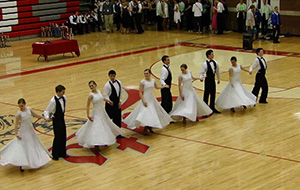 Strictly Ballroom – The Musical, the musical theatre adaptation of the much-loved film will be playing at the West Yorkshire Playhouse in December, and full casting has recently been announced for the UK premiere. The musical tells the story of a championship ballroom dancer, Scott, risking his successful career by performing unusual routines, in a bid to remain true to himself and his own interpretation of dance.
Strictly Ballroom – The Musical, the musical theatre adaptation of the much-loved film will be playing at the West Yorkshire Playhouse in December, and full casting has recently been announced for the UK premiere. The musical tells the story of a championship ballroom dancer, Scott, risking his successful career by performing unusual routines, in a bid to remain true to himself and his own interpretation of dance.
The film version was created by Baz Luhrmann and his wife Catherine Martin, and since then the show made its world premiere at the Sydney Lyric Theatre in April 2014. Rising star Gemma Sutton will star as Fran alongside Sam Lips, who will make his UK debut as Scott. Sutton also starred in the recent productions Gypsy and The Go-Between, alongside Imelda Staunton and Michael Crawford respectively, and performances to Lips’ name include Pippin and Wicked.
Another name on the up is the definitive Drew McOnie, who will both direct and choreograph the production. His Jekyll and Hyde recently ran at The Old Vic to great acclaim, a great coup for the Olivier Award winner. The Strictly Ballroom cast also includes Tamsin Carroll (Miss Saigon), Stephen Matthews (The Lion King), Julius D’Silva (Made in Dagenham), Richard Grieve (Priscilla – Queen of the Desert), Eve Polycarpou (In the Heights) and Charlotte Gooch (Dirty Dancing).
There is no word yet as to whether the show will tour following its run at the Playhouse in Yorkshire, on from 6 December until 21 January 2017, with previews from 30 November. Dealing with such a popular and well-loved story it seems audiences can only hope that the production will journey around the country and then down to the capital.
Alvin Ailey American Dance Theater
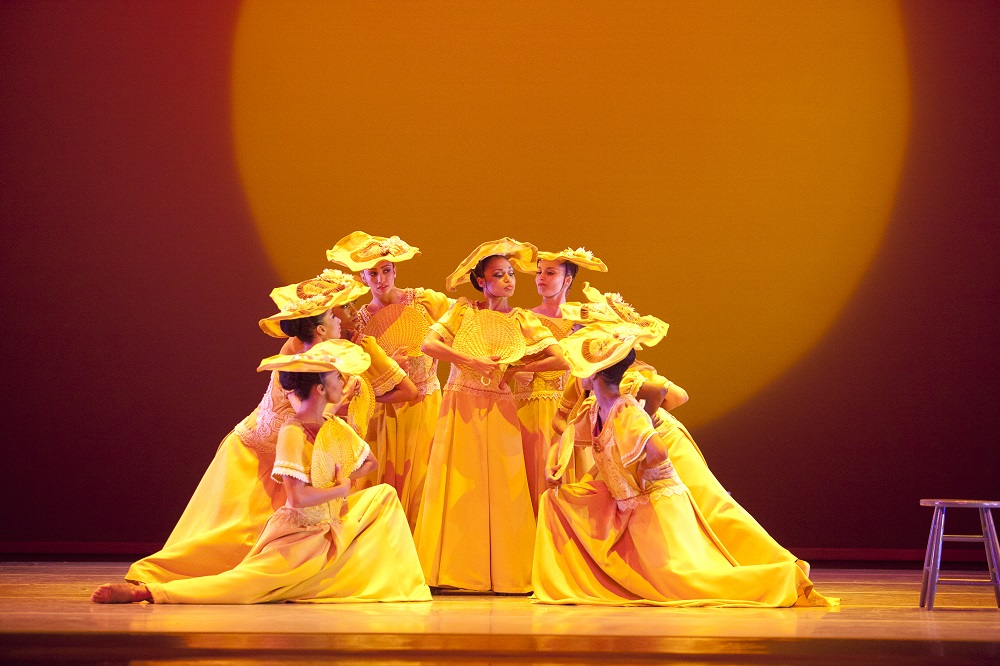 In a few short weeks, the iconic Alvin Ailey American Dance Theater will be descending on the UK to delight and impress audiences all over the country. As one of the world’s most popular dance companies, its return to the UK is further significant due to the fact it is the first time in over six years. During the company’s performances in the UK, it will present 10 works during six exhilarating programmes, including its Revelations masterpiece.
In a few short weeks, the iconic Alvin Ailey American Dance Theater will be descending on the UK to delight and impress audiences all over the country. As one of the world’s most popular dance companies, its return to the UK is further significant due to the fact it is the first time in over six years. During the company’s performances in the UK, it will present 10 works during six exhilarating programmes, including its Revelations masterpiece.
The tour will start with a two-week, four-programme season at Sadler’s Wells, London on 6 September and it will conclude at Festival Theatre, Edinburgh on 19 October. The tour will see Alvin Ailey American Dance Theater visit 10 venues, rather than just limiting its performances to London only. What a treat for regional audiences too! The company’s autumn tour marks the fourth time Ailey is presented by Dance Consortium, a group of 17 large scale venues located across the UK.
Alvin Ailey American Dance Theater, founded in 1958, is recognised by the US Congress as a vital American “Cultural Ambassador to the World”, in its presentation of constantly high-quality work and performances which are second to none. Under the leadership of Artistic Director Robert Battle (the Company’s third artistic leader in its almost 60 year history), Ailey’s performances celebrate the human spirit through the African-American cultural experience and the American modern dance tradition. This was initiated by Ailey’s reliance on his ‘blood memories’ of growing up in the US.
Since 1958, Ailey’s performers have performed for over 25 million people in 71 countries, on a total of six continents.
Ballet in the Maldives
 Ballet is without doubt a love worldwide, however focus has recently been on the Maldives, where guests at two luxury hotels will be lucky enough to experience exclusive ‘floating’ ballet performances. Guests staying at PER AQUUM Niyama and PER AQUUM Huvafen Fushi on the nights of 21 and 23 August will be treated to special performances that fuse the choreography of iconic ballets Swan Lake, Giselle, Carmen, Scheherazade and Don Quixote.
Ballet is without doubt a love worldwide, however focus has recently been on the Maldives, where guests at two luxury hotels will be lucky enough to experience exclusive ‘floating’ ballet performances. Guests staying at PER AQUUM Niyama and PER AQUUM Huvafen Fushi on the nights of 21 and 23 August will be treated to special performances that fuse the choreography of iconic ballets Swan Lake, Giselle, Carmen, Scheherazade and Don Quixote.
The shows will take place on specially-designed stages over the water, presented by Russia’s Mariinsky company this summer. The brains behind the project is British-born dancer Xander Parish, who became the first British dancer to join the Mariinsky in 2010. Arranging the performances single-handedly, he has specially selected his cast of Mariinsky dancers for the Maldives trip to perform. The dancers include Oksana Bondareva and Renata Shakirova, set to delight hotel guests during their stay.
The unique performance event is taking place at two of the most fashionable and exclusive hotels in the Maldives. PER AQUUM Huvafen Fushi is a private island hotel that hosts the only underwater spa in the world, and PER AQUUM Niyama was the proud owner of the world’s first underwater nightclub, before recently revamping it as a restaurant. What better element to add to guests’ stays than a floating ballet performance whilst they are holidaying.
Aspiring ballet dancers amongst the guests will also have the chance to take part in one of several dancing masterclasses during the Mariinsky’s time in the Maldives. These classes will be run by Parish at both resorts throughout his visit encouraging guests to engage with a new activity, inspired by the performances from the dancers. This may well be a welcome alternative to the usual fitness classes offered at resorts such as these, or just a chance to try something new and have fun whilst doing so.
New “World of Dance” competition
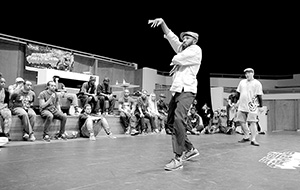 Pop star and reality television show judge Jennifer Lopez is said to be on the hunt for the best dancers in the world for a new reality competition series. She has partnered up with executive bosses at the NBC network to produce the series, and international dance brand World of Dance. The show will feature elite dancers from around the globe who are aspiring to break into the professional dance industry.
Pop star and reality television show judge Jennifer Lopez is said to be on the hunt for the best dancers in the world for a new reality competition series. She has partnered up with executive bosses at the NBC network to produce the series, and international dance brand World of Dance. The show will feature elite dancers from around the globe who are aspiring to break into the professional dance industry.
The hugely successful singer began her career as a dancer, and is now using her first passion to help a new generation of professional dancers to make their mark in the industry and kick-start their careers, with the show which will be titled “World of Dance”. Jennifer Lopez will executive produce the series with her long-time partner Benny Medina. She is well versed in this area, having previously served as a judge on the hit singing series “American Idol”, and also produced 2007’s “Dancelife”, which focused on the lives of seven dancers attempting to break into the world of professional dance.
For “World of Dance”, the competitors will be split into three divisions – those under the age of 16, individuals over the age of 16, and groups, as their own classification. The participants will compete in various dance genres including hip-hop, tap, ballet, ballroom and more, competing against each other in duels until one act in each division is left. The finale of the 10-episode series will therefore feature the winners from each division who will be competing for a $1 million grand prize.
It is clear that “World of Dance” will be talent-heavy and tough. Emmy-winning choreographers Tabitha and Napoleon D’umo, who frequently collaborate with Jennifer Lopez and created her dance moves for her Las Vegas residency show, are also on board to develop choreography for the show.
